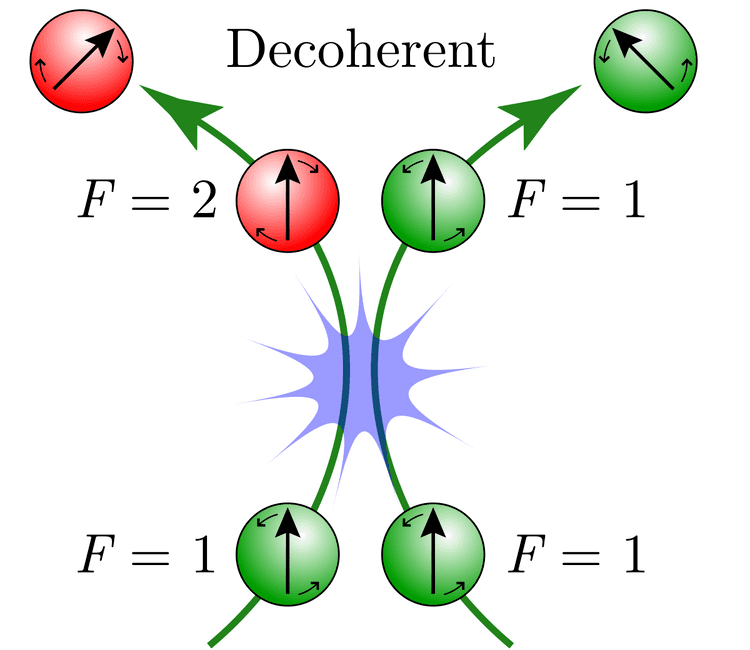 | ||
A spin exchange relaxation-free (SERF) magnetometer is a type of magnetometer developed at Princeton University in the early 2000s. SERF magnetometers measure magnetic fields by using lasers to detect the interaction between alkali metal atoms in a vapor and the magnetic field.
Contents
- Spin exchange relaxation
- Sensitivity
- Typical operation
- Advantages and disadvantages
- Applications
- History
- References
The name for the technique comes from the fact that spin exchange relaxation, a mechanism which usually scrambles the orientation of atomic spins, is avoided in these magnetometers. This is done by using a high (1014 cm−3) density of Potassium atoms and a very low magnetic field. Under these conditions, the atoms exchange spin quickly compared to their magnetic precession frequency so that the average spin interacts with the field and is not destroyed by decoherence.
A SERF magnetometer achieves very high magnetic field sensitivity by monitoring a high density vapor of alkali metal atoms precessing in a near-zero magnetic field. The sensitivity of SERF magnetometers improves upon traditional atomic magnetometers by eliminating the dominant cause of atomic spin decoherence caused by spin-exchange collisions among the alkali metal atoms. SERF magnetometers are among the most sensitive magnetic field sensors and in some cases exceed the performance of SQUID detectors of equivalent size. A small 1 cm3 volume glass cell containing potassium vapor has reported 1 fT/√Hz sensitivity and can theoretically become even more sensitive with larger volumes. They are vector magnetometers capable of measuring all three components of the magnetic field simultaneously.
Spin-exchange relaxation
Spin-exchange collisions preserve total angular momentum of a colliding pair of atoms but can scramble the hyperfine state of the atoms. Atoms in different hyperfine states do not precess coherently and thereby limit the coherence lifetime of the atoms. However, decoherence due to spin-exchange collisions can be nearly eliminated if the spin-exchange collisions occur much faster than the precession frequency of the atoms. In this regime of fast spin-exchange, all atoms in an ensemble rapidly change hyperfine states, spending the same amounts of time in each hyperfine state and causing the spin ensemble to precess more slowly but remain coherent. This so-called SERF regime can be reached by operating with sufficiently high alkali metal density (at higher temperature) and in sufficiently low magnetic field.
The spin-exchange relaxation rate
where
In the limit of fast spin-exchange and small magnetic field, the spin-exchange relaxation rate vanishes for sufficiently small magnetic field:
where
where
Sensitivity
The sensitivity
where
In the absence of spin-exchange relaxation, a variety of other relaxation mechanisms contribute to the decoherence of atomic spin:
where
In an optimal configuration, a density of 1014 cm−3 potassium atoms in a 1 cm3 vapor cell with ~3 atm helium buffer gas can achieve 10 aT Hz−1/2 (10−17 T Hz−1/2) sensitivity with relaxation rate
Typical operation
Alkali metal vapor of sufficient density is obtained by simply heating solid alkali metal inside the vapor cell. A typical SERF atomic magnetometer can take advantage of low noise diode lasers to polarize and monitor spin precession. Circularly polarized pumping light tuned to the
Advantages and disadvantages
SERF magnetometers compete with SQUID magnetometers for use in a variety of applications. The SERF magnetometer has the following advantages:
Potential disadvantages:
Applications
Applications utilizing high sensitivity of SERF magnetometers potentially include:
History
The SERF magnetometer was developed by Michael V. Romalis at Princeton University in the early 2000s. The underlying physics governing the suppression spin-exchange relaxation was developed decades earlier by William Happer but the application to magnetic field measurement was not explored at that time. The name "SERF" was partially motivated by its relationship to SQUID detectors in a marine metaphor.
